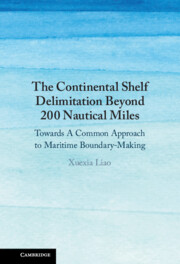 The Continental Shelf Delimitation Beyond 200 Nautical Miles
The Continental Shelf Delimitation Beyond 200 Nautical Miles from Part I - Overlapping Entitlements to the Continental Shelf beyond 200 Nautical Miles
Published online by Cambridge University Press: 08 October 2021
Maritime delimitation presupposes an area of overlapping entitlements. Instead of focusing solely on the geomorphological and geological elements of the entitlement, this chapter surveys the State practice in order to contextualize the determination of overlapping entitlements to the continental shelf beyond 200 nm. Factors including the outer limits of the continental shelf, maritime delimitation within 200 nm, and the existence of multiple claims to the same continental shelf beyond 200 nm may play out in the determination of the overlapping entitlements to the continental shelf beyond 200 nm. Moreover, two scenarios wherein the existence of overlapping entitlements is doubtful are also examined. The first concerns the situation where two different parties invoke the two continental shelf criteria under Article 76 of the United Nations Convention on the Law of the Sea in a confined maritime area, which underlies the disputes of the Nicaragua v. Colombia cases. The other concerns the "zone-locked" scenario, in which a State’s access to the continental shelf beyond 200 nm is closed off by a maritime boundary within 200 nm.
To save this book to your Kindle, first ensure no-reply@cambridge.org is added to your Approved Personal Document E-mail List under your Personal Document Settings on the Manage Your Content and Devices page of your Amazon account. Then enter the ‘name’ part of your Kindle email address below. Find out more about saving to your Kindle.
Note you can select to save to either the @free.kindle.com or @kindle.com variations. ‘@free.kindle.com’ emails are free but can only be saved to your device when it is connected to wi-fi. ‘@kindle.com’ emails can be delivered even when you are not connected to wi-fi, but note that service fees apply.
Find out more about the Kindle Personal Document Service.
To save content items to your account, please confirm that you agree to abide by our usage policies. If this is the first time you use this feature, you will be asked to authorise Cambridge Core to connect with your account. Find out more about saving content to Dropbox.
To save content items to your account, please confirm that you agree to abide by our usage policies. If this is the first time you use this feature, you will be asked to authorise Cambridge Core to connect with your account. Find out more about saving content to Google Drive.